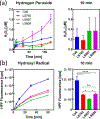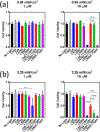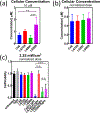Trafficking of a Single Photosensitizing Molecule to Different Intracellular Organelles Demonstrates Effective Hydroxyl Radical-Mediated Photodynamic Therapy in the Endoplasmic Reticulum
- PMID: 31009564
- PMCID: PMC7339605
- DOI: 10.1021/acs.bioconjchem.9b00192
Trafficking of a Single Photosensitizing Molecule to Different Intracellular Organelles Demonstrates Effective Hydroxyl Radical-Mediated Photodynamic Therapy in the Endoplasmic Reticulum
Abstract
Photodynamic therapy (PDT) is often used in preclinical and clinical treatment regimens. Reactive oxygen species (ROS) generated by photosensitizers (PSs) upon exposure to light induce cell death via diverse mechanisms. PSs can exert therapeutic effects in different cellular organelles, although the efficacy of organelle-specific PDT has yet to be determined as most previous studies use different PSs in different organelles. Here, we explored how a single PS, chlorin e6 (Ce6), targeted to different organelles altered the effectiveness of PDT. Ce6 intrinsically localizes to the ER after 4 h of incubation. Modification of Ce6 via conjugation with an octapeptide (LS765), a monosubstituted triphenylphosphonium (TPP) derivative (LS897), or a disubstituted TPP derivative (LS909) altered the intrinsic localization. We determined that LS765 and LS9897 predominantly accumulated in the lysosomes, but LS909 trafficked equally to both the mitochondria and the lysosomes. Moreover, the conjugation altered the type of ROS produced by Ce6, increasing the ratio of hydrogen peroxide to hydroxyl radicals. Irradiation of identical concentrations of the PSs in solution with 650 nm, 0.84 mW/cm2 light for 10 min showed that the TPP conjugates nearly doubled the hydrogen peroxide production from ∼0.2 μM for Ce6 and LS765 to ∼0.37 μM for LS897 and LS909. In contrast, Ce6 produced ∼1.5-fold higher hydroxyl radicals than its conjugates. To compare the effect of each PS on cell death, we normalized the intracellular concentration of each PS. Hydrogen peroxide-producing PSs are effective PDT agents in the lysosomes while the hydroxyl-generating PSs are very effective in the ER. Compared to the PSs that accumulated in the lysosomes, only the ER-targeted Ce6 exerted >50% cell death at either low light power or low intracellular concentration. By delineating the contributions of cellular organelles and types of ROS produced, our work suggests that targeting hydroxyl radical-producing PSs to the ER is an exciting strategy to improve the therapeutic outcome of PDT.
Conflict of interest statement
The authors declare no competing financial interest.
Figures





Similar articles
-
An endoplasmic reticulum and lipid droplets dual-localized strategy to develop small molecular photosensitizers that induce ferroptosis during photodynamic therapy.Eur J Med Chem. 2025 Mar 15;286:117306. doi: 10.1016/j.ejmech.2025.117306. Epub 2025 Jan 21. Eur J Med Chem. 2025. PMID: 39854940
-
Tuning Organelle Specificity and Photodynamic Therapy Efficiency by Molecular Function Design.ACS Nano. 2019 Oct 22;13(10):11283-11293. doi: 10.1021/acsnano.9b04430. Epub 2019 Sep 18. ACS Nano. 2019. PMID: 31525947
-
Photolon™ --photosensitization induces apoptosis via ROS-mediated cross-talk between mitochondria and lysosomes.Int J Oncol. 2011 Oct;39(4):821-31. doi: 10.3892/ijo.2011.1109. Epub 2011 Jul 1. Int J Oncol. 2011. PMID: 21725591
-
Organelle-Targeted Photosensitizers for Precision Photodynamic Therapy.ACS Appl Mater Interfaces. 2021 May 5;13(17):19543-19571. doi: 10.1021/acsami.1c02019. Epub 2021 Apr 26. ACS Appl Mater Interfaces. 2021. PMID: 33900741 Review.
-
Organelle-targeted small molecular photosensitizers for enhanced photodynamic therapy: a minireview for recent advances and potential applications.Chem Commun (Camb). 2025 May 13;61(40):7236-7252. doi: 10.1039/d5cc01642h. Chem Commun (Camb). 2025. PMID: 40289926 Review.
Cited by
-
Activation of nano-photosensitizers by Y-90 microspheres to enhance oxidative stress and cell death in hepatocellular carcinoma.Sci Rep. 2022 Jul 26;12(1):12748. doi: 10.1038/s41598-022-17185-0. Sci Rep. 2022. PMID: 35882949 Free PMC article.
-
Combined bisdemethoxycurcumin and potassium iodide-mediated antimicrobial photodynamic therapy.Heliyon. 2023 Jun 27;9(7):e17490. doi: 10.1016/j.heliyon.2023.e17490. eCollection 2023 Jul. Heliyon. 2023. PMID: 37455953 Free PMC article.
-
Brain endothelial cell-derived extracellular vesicles with a mitochondria-targeting photosensitizer effectively treat glioblastoma by hijacking the blood‒brain barrier.Acta Pharm Sin B. 2023 Sep;13(9):3834-3848. doi: 10.1016/j.apsb.2023.03.023. Epub 2023 Mar 31. Acta Pharm Sin B. 2023. PMID: 37719366 Free PMC article.
References
-
- Wilson BC, and Patterson MS (2008) The physics, biophysics and technology of photodynamic therapy. Phys. Med. Biol 53, R61–109. - PubMed
-
- Pandey RK (2000) Recent advances in photodynamic therapy. J. Porphyrins Phthalocyanines 4, 368–373.
-
- Brunk UT, and Ericsson JLE (1972) Cytochemical evidence for the leakage of acid phosphatase through ultrastructurally intact lysosomal membranes. Histochem. J 4, 479–91. - PubMed
Publication types
MeSH terms
Substances
Grants and funding
LinkOut - more resources
Full Text Sources
Other Literature Sources

